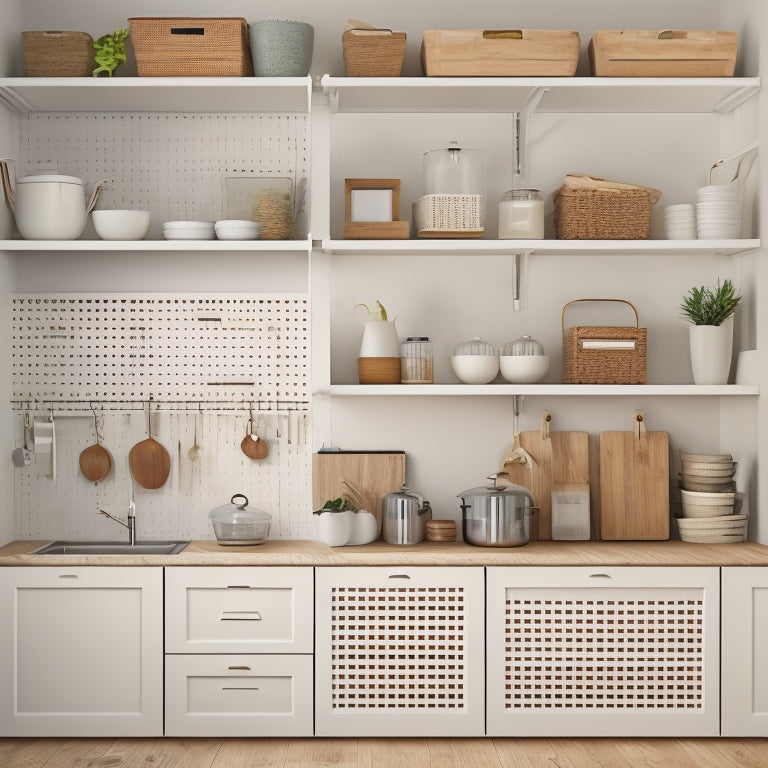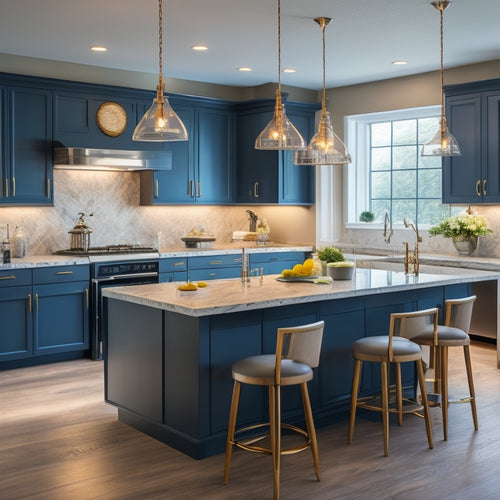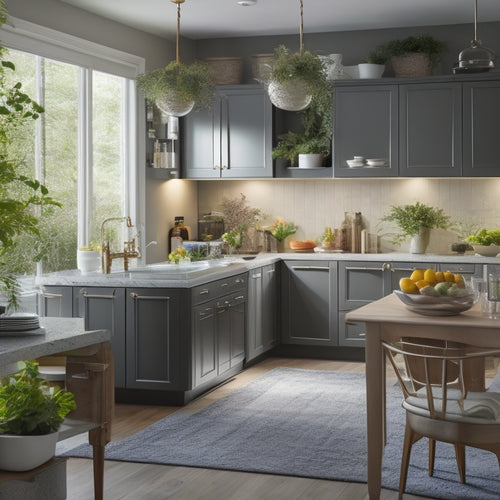
10 Simple Ways to Organize Small Kitchen Cabinets
Share
You can easily optimize your small kitchen cabinets by implementing a few simple strategies. Start by maximizing vertical storage space with stackable containers and adjustable shelves. Assign a home for each item, categorizing kitchen essentials into groups and zones for easy retrieval. Employ the back of doors with storage racks and magnetic spice strips. Choose the right cabinets that fit your kitchen's unique dimensions, and optimize corner cabinet storage with lazy susan solutions. Store heavy items below eye level, and invest in labeling techniques to keep contents organized. By applying these tactics, you'll be well on your way to a more functional and efficient kitchen - and there's even more you can do to take your organization to the next level.
Key Takeaways
- Maximize vertical storage space with stackable containers, vertical dividers, and smart storage solutions to optimize cabinet capacity.
- Assign a home for each item by categorizing kitchen items into groups, creating zones, and designating specific storage solutions for each category.
- Utilize the back of doors with door-mounted storage racks, magnetic spice strips, and over-the-door baskets to maximize often-wasted space.
- Implement a spice rack system using magnetic strips, tiered racks, or carousels to enhance cooking experience and reduce stress.
- Choose the right cabinets by selecting durable materials, opting for flat-panel or Shaker-style designs, and considering custom cabinets to fit unique kitchen dimensions.
Maximize Vertical Storage Space
By the time you start organizing your small kitchen cabinets, maximizing vertical storage space is essential.
You'll be surprised at how much more room you can create by using stackable containers and vertical dividers. Installing smart storage solutions can also help optimize space and improve ingredient accessibility.
Start by evaluating the height of your cabinets and identifying areas where you can install shelves or hooks. Then, invest in stackable containers that can hold items like plates, bowls, and cups. Label each container so you can easily find what you need.
Vertical dividers can also help keep similar items, like baking supplies or spices, organized and within reach. By making the most of your cabinet's vertical space, you'll be able to store more items without cluttering your countertops.
Assign a Home for Each Item
You'll want to categorize your kitchen items into groups, such as baking supplies, cooking utensils, and dinnerware, to make it easier to assign a home for each item.
This process is similar to creating a logical filing system streamlining digital systems in your digital spaces, which can help improve mental clarity and efficiency.
Next, you'll create zones within your cabinets for easy access, designating specific areas for frequently used items and less frequently used ones.
Item Categories Defined
Now that you've purged your kitchen of unnecessary items, it's time to categorize what's left and assign a home for each item.
Start by grouping similar items together, such as baking supplies, cooking utensils, and dinnerware. Within each group, categorize items based on frequency of use, size, and type.
For example, kitchen tools like whisks and spatulas can be stored together in a designated drawer or container. Assign a specific storage solution, like a basket or bin, for each category.
This will help you visualize the layout of your kitchen and make certain everything has a designated spot. By defining these categories, you'll be able to find what you need quickly and easily, making cooking and cleaning a breeze.
Zones for Easy Access
With your categorized items in hand, it's time to create zones for easy access within your kitchen cabinets. Assign a home for each item to optimize your kitchen workflow and efficient cooking. This means designating specific areas for frequently used items, like cooking essentials near the stove, and less frequently used items towards the back or on higher shelves.
| Zone | Items |
|---|---|
| Cooking Zone | Pots, pans, utensils, oils |
| Baking Zone | Baking sheets, mixing bowls, whisk |
| Storage Zone | Infrequently used items, special occasion dishes |
Utilize the Back of Doors
You can maximize the potential of your small kitchen cabinets by utilizing the back of doors for additional storage.
By installing door-mounted storage racks, you can hang infrequently used items like special occasion dishes or cookbooks.
You can also attach magnetic spice strips or over-the-door baskets to keep essentials within easy reach.
Door-Mounted Storage Racks
Every available inch counts in a small kitchen, and the back of doors is a prime spot to maximize storage. By installing door-mounted storage racks, you can make the most of this often-wasted space.
These racks are perfect for holding infrequently used items like special occasion dishes, cookbooks, or even cleaning supplies. They're also great for storing snacks, spices, or oils, keeping them within easy reach.
Look for adjustable door racks that can be customized to fit your specific needs. With door-mounted storage racks, you'll be amazed at how much more space-efficient your kitchen becomes.
You'll be able to find what you need quickly and easily, and your kitchen will feel more organized and in control.
Magnetic Spice Strips
The back of doors continues to be a worthwhile real estate in your small kitchen, and magnetic spice strips are another clever way to employ this space. By utilizing magnetic spice strips, you can maximize your kitchen's storage capacity and keep your spices within easy reach.
Here's how you can optimize your magnetic spice organization:
-
Choose the right size: Select magnetic spice strips that fit the back of your kitchen door and can hold the number of spice jars you need to store.
-
Label your spice jars: Use spice jar labels to identify the contents of each jar, ensuring you can quickly find the spice you need.
-
Store frequently used spices front and center: Place your most frequently used spices in the easiest-to-reach locations, making it simple to access them while cooking.
Over-the-Door Baskets
How can you convert the often-wasted space on the back of your kitchen doors into a storage haven? By utilizing over-the-door baskets, you can maximize your kitchen's storage capacity without sacrificing accessibility. These baskets provide a convenient and easy-to-reach storage solution for items like spices, oils, or snacks.
| Basket Type | Benefits | Ideal for Storing |
|---|---|---|
| Adjustable | Fits different door sizes | Spices, oils, snacks |
| Stackable | Saves vertical space | Canned goods, kitchen utensils |
| Hanging | Frees up floor space | Pots, pans, kitchen linens |
| Shelf-style | Provides additional counter space | Kitchen gadgets, cookbooks |
With over-the-door baskets, you can achieve peak kitchen accessibility and organization. By choosing the right basket type for your needs, you'll be able to store more items in a compact and convenient way, making the most of your small kitchen cabinet space.
Choose the Right Cabinets
Since you're working with limited space, selecting the right cabinets is essential to maximizing your small kitchen's storage capacity. You want cabinets that provide ample storage without overwhelming the space.
When choosing cabinets, consider the following factors:
-
Cabinet materials: Select materials that are durable, easy to clean, and resistant to moisture. Popular options include solid wood, MDF, and laminate.
-
Cabinet styles: Opt for styles that create a sense of openness, such as flat-panel or Shaker-style cabinets. Avoid ornate or bulky designs that can make the space feel cramped.
-
Customization: Consider custom cabinets that fit your kitchen's unique dimensions and layout. This can help you make the most of every inch of space.
Optimize Corner Cabinet Storage
Corner cabinets often prove to be the most challenging areas to organize in small kitchens, as their unique shape and location can make it difficult to access and make use of the available space.
To optimize corner cabinet storage, you'll need to think creatively. One effective solution is to install lazy susan solutions, which allow you to easily access items in the back of the cabinet without having to dig through everything else.
You can also consider pull-out shelves, which can be customized to fit your specific needs and make it easy to retrieve items.
Implement a Spice Rack System
Across from the cooktop or nestled beside the sink, a well-designed spice rack system can enhance your cooking experience and free up precious real estate in your small kitchen cabinets.
By implementing a spice rack system, you'll be able to easily find the spices you need, reducing cooking time and stress.
To maximize spice jar organization and creative spice storage, consider the following:
-
Magnetic Spice Strips: Attach magnetic strips to the side of a cabinet or fridge to store small spice jars, keeping them within easy reach.
-
Tiered Spice Racks: Install a tiered spice rack on a wall or inside a cabinet door to create a visually appealing and functional storage solution.
-
Spice Carousels: Employ a spice carousel to rotate your spices, making it easy to access the ones in the back and ensuring you use the oldest ones first.
Store Heavy Items Below
Three quarters of your kitchen's heavy items, such as pots, pans, and appliances, are likely used daily or weekly.
Storing them below eye level is essential for heavy item safety and cabinet weight distribution. You'll avoid straining your back and shoulders when retrieving these items, and your cabinets will be less likely to tip over.
Designate the lower cabinets for these heavy items, reserving the upper cabinets for lighter items like plates, glasses, and utensils. This strategic storage plan will create a more balanced and organized kitchen.
Invest in Adjustable Shelves
Now that you've designated the lower cabinets for heavy items, it's time to maximize the storage capacity of these cabinets with adjustable shelves.
Adjustable shelves offer flexibility and customization, allowing you to optimize your storage space. When choosing adjustable shelves, consider the following factors:
-
Shelf materials: Select shelves made from durable materials, such as wood or metal, that can hold the weight of your kitchen items.
-
Shelf height: Adjust the shelf height to accommodate items of varying sizes, ensuring easy access and visibility.
-
Customization options: Look for shelves with customization options, such as removable or repositionable shelves, to create a layout that suits your needs.
Label and Categorize Contents
You'll get the most out of your newly organized small kitchen cabinets by categorizing contents into groups like baking supplies, cooking essentials, and dinnerware.
Create zones for food storage, such as a snack area or a spice station, to make meal prep a breeze.
Kitchen Item Categories
Behind the doors of your small kitchen cabinets lies a wealth of items, each serving a specific purpose.
To effectively categorize them, you'll need to group similar items together. This will help you create a sense of control and make the most of your kitchen essentials.
Create categories by grouping items into the following:
- Cooking Essentials: pots, pans, utensils, and cookware
- Dining and Serving: plates, bowls, cups, and silverware
- Food Preparation: spices, oils, condiments, and kitchen gadgets
Food Storage Zones
By categorizing your kitchen items, you've taken the first step in organizing your small kitchen cabinets.
Now, it's time to create food storage zones. This involves grouping similar items together based on their purpose and frequency of use. Designate areas for dry goods, canned goods, and perishable items.
Consider implementing food preservation techniques, such as storing food in airtight containers to maintain freshness.
Apply pantry organization tips, like storing heavy items at the bottom and lighter ones at the top, to maximize space.
Labeling Essentials
A well-organized kitchen cabinet is like a treasure chest, where every item has its designated place and purpose.
You've worked hard to categorize and store your kitchen essentials, now it's time to take it to the next level with labeling techniques. This step guarantees you can quickly find what you need, saving you time and frustration.
To effectively label your cabinet contents, try these methods:
-
Use a consistent font and size to create a cohesive look and make labels easy to read.
-
Implement color coding to distinguish between categories, such as baking supplies or cooking utensils.
-
Keep labels concise by using short descriptions or abbreviations to avoid clutter.
Purge and Edit Cabinet Contents
Your kitchen cabinets are likely filled with a jumbled mix of items you use regularly, occasionally, or not at all.
It's time to purge and edit their contents. Start by removing everything from your cabinets and sorting items into three piles: keep, donate unused, and discard.
Be ruthless – if you haven't used it in the past year, it's probably safe to get rid of it. Declutter items that are broken, expired, or no longer serve a purpose.
Consider donating gently used items to a local charity or thrift store.
Once you've pared down your collection, you'll be left with only the essentials, making it easier to organize what's left and maintain your newly decluttered space.
Frequently Asked Questions
How Do I Prevent Clutter From Building up in the Future?
To prevent clutter from building up in the future, you'll maintain your space by implementing clutter prevention habits, like daily tidying and weekly deep cleans, and develop maintenance strategies that fit your lifestyle to keep your kitchen organized and clutter-free.
Can I Organize My Kitchen Cabinets on a Tight Budget?
You're a skilled chef steering through a cluttered kitchen, but don't let budget constraints hold you back. You can whip up an organized space with budget-friendly tools and creative storage solutions, maximizing every inch without breaking the bank.
Are There Any Eco-Friendly Kitchen Cabinet Organization Options?
You're looking for eco-friendly kitchen cabinet organization options, and you'll be happy to know that you can find sustainable materials and zero waste storage solutions that fit your values and help you stay organized, all while reducing your environmental footprint.
How Do I Organize My Kitchen Cabinets if I Have Limited Mobility?
You'll want to prioritize accessible storage and easy reach when organizing your kitchen cabinets with limited mobility. Install pull-out shelves, Lazy Susans, or adjustable baskets to reduce straining and make essentials easily accessible.
Can I Use DIY Solutions to Organize My Kitchen Cabinets?
You can definitely use DIY solutions to organize your kitchen cabinets, and with a little creativity, you'll find plenty of diy storage ideas that offer creative solutions to maximize your space and make the most of your kitchen's potential.
Related Posts
-

Laundry Room Storage Hacks for Tiny Spaces
You're working with a tiny laundry room, and every square inch counts. To maximize storage, start by utilizing vertic...
-

7 Kitchen Island Designs With Built-In Seating
You're looking for a kitchen island that not only provides additional counter space and storage but also incorporates...
-

Why Corner Cabinets Are a Kitchen Essential
You're sitting on a goldmine of untapped storage potential in your kitchen - the often-wasted corner spaces that can ...


